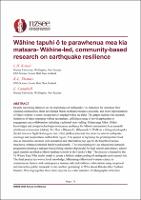Wāhine tapuhi ō te parawhenua mea kia mataara- Wāhine-led, community-based research on earthquake resilience

Download
Date
2020-04-22Authors
Kaiser, Lucy
Thomas, Kristie-Lee
Campbell, Emily
Metadata
Show full item recordAbstract
Despite increasing attention on the importance of earthquake risk reduction for Aotearoa New Zealand communities, there are limited Māori-medium resources available, and more representation of Māori wāhine (women) researchers is needed within the field. This paper explores the research initiatives of three emerging wāhine researchers, utilising a range of novel approaches to engagement and collaboration including traditional story-telling, Mātauranga Māori (Māori knowledge) and design technologies to increase resilience for Māori communities from tamariki (children) to kaumatua (elders). Te Hīkoi a Rūaumoko (Rūaumoko’s Walk) is a bilingual pukapuka (book) based on Ngāti Kahungunu iwi (tribe) pūrākau (stories) that relate to natural earthquake warnings and preparedness within their region. This project is digitising the printed picture book into an interactive medium with animation and information pop ups for the benefit of kaiako (teachers), whānau (extended family) and tamariki. The second project is an educational outreach programme piloting a tuakana/teina (sibling) mentorship model for high school and primary school-aged students enrolled at Māori-medium schools in the Hawke’s Bay. The project is framed by the Te Whare Tapa Wha health model to create a holistic understanding of earthquake and tsunami risk. The final project has woven local knowledge, Mātauranga Māori and western science to communicate historic and contemporary tsunami risk and resilience information using reciprocal and interactive public memorial events and hui (gathering) in Wharekauri-Rekohu (the Chatham Islands). Weaving together these three projects is a wider narrative of ethnographic reflection exploring the role of three emerging wāhine researchers collaborating in the discipline of seismic research and the challenges and successes involved within this.
